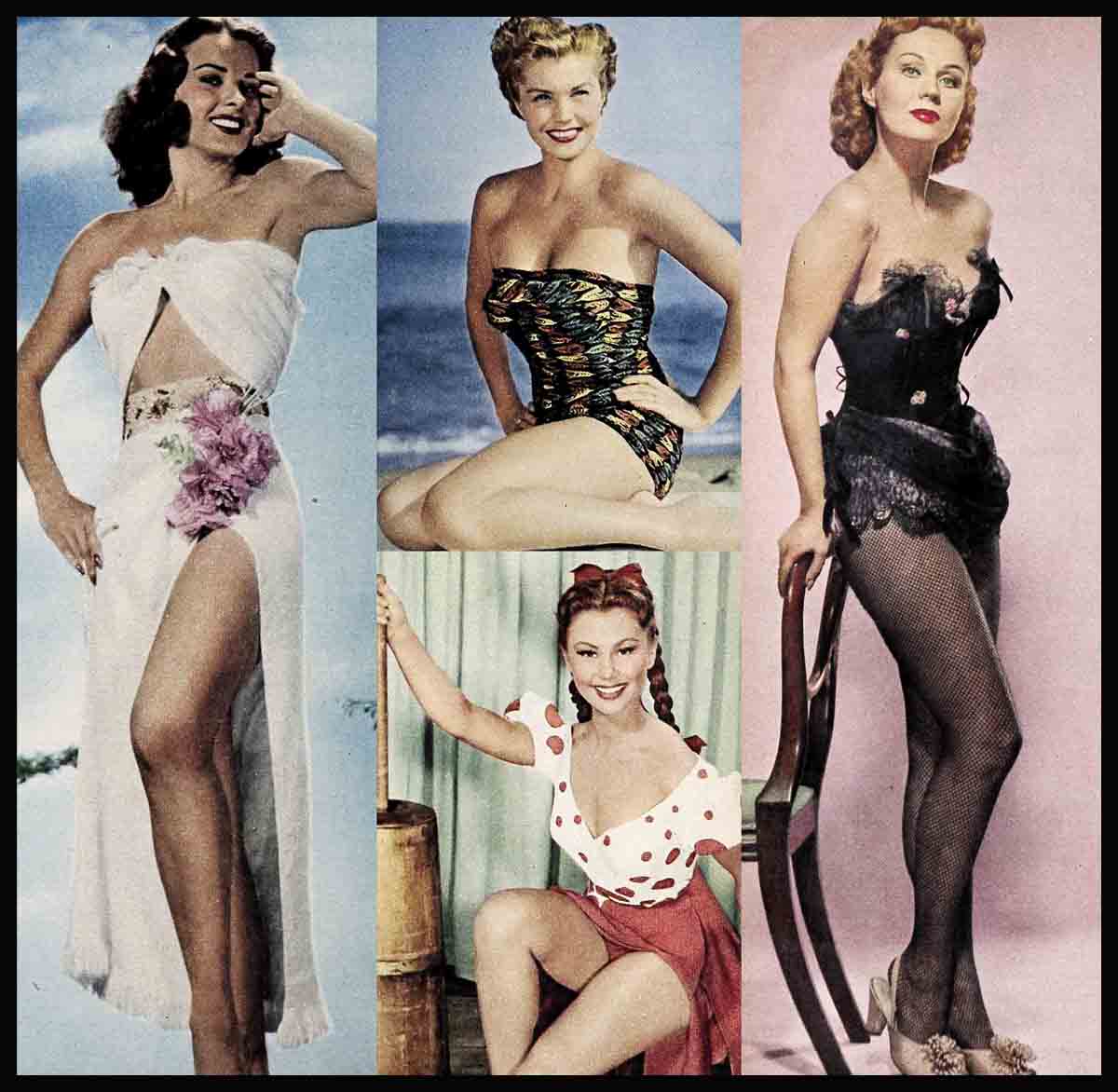
Hollywood’s Top Pinups
Top pinup girls of Hollywood currently are Esther Williams, Mitzi Gaynor, Virginia Mayo, Marilyn Monroe, Jean Peters, Debbie Reynolds, Jane Russell, Janet Leigh, Rita Hayworth and Vera-Ellen. These are the stars who get hundreds, thousands, of pinup requests every week.
The Los Angeles General Post Office is the place to prove which pinup dolls rank first with the lads in uniform.
Long before the fan letters get sorted out for the branches in Hollywood, Beverly Hills or other luxury locales in the movie colony, the Los Angeles General Post Office gets the load flooding in from every camp in this country—plus Alaska, Hawaii, Japan, occupied Germany and fighting Korea. And as the uniformed contingent goes, so go the males of the nation.
Let it be known then, that at Los Angeles General P. O., a dish named Marilyn Monroe, too young to be known during World War II, curves into a class by herself. In the orders of the big post office, Miss Monroe has “the status of big business.” Translated, that means that marvelous Marilyn is treated (by the letter, you understand) exactly like the Los Angeles Stock Exchange, or the Chamber of Commerce or similar institutions. Her mail is packaged together, under her own “firm” wrapper, duly printed “M. MONROE,” each package containing 300 letters. These in turn are put in a wrapped “M. MONROE” mailbag for delivery to Twentieth Century-Fox.
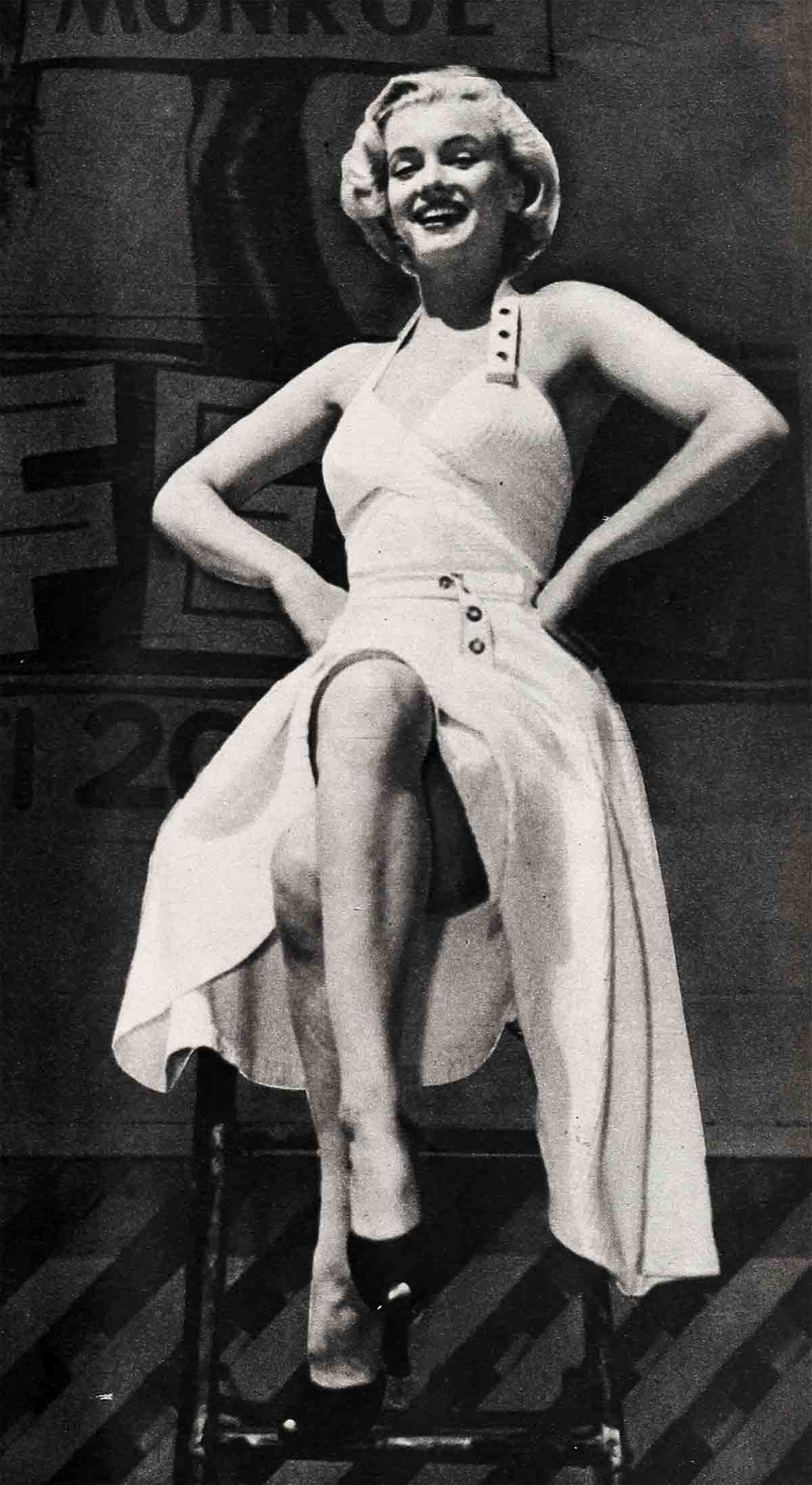
All this pleases Marilyn, and no wonder. She is grateful that her studio is willing to supply these photographs to her free, and she, in turn, willingly poses for new sittings almost weekly.
“You learn about what men like from pinup requests,” Marilyn says. “When I first started posing for these pictures, I went along with the studio idea that the more undressed I was, the more popular my photographs would be. But that isn’t so. The boys write that in addition to bathing suits, they like to see me in a simple street dress or in a skirt and sweater.” Then she dimples. “Of course, they write that they want the skirt to be short and tight and the sweater to be tighter. And if it’s a dress, they want the neckline really to plunge.”
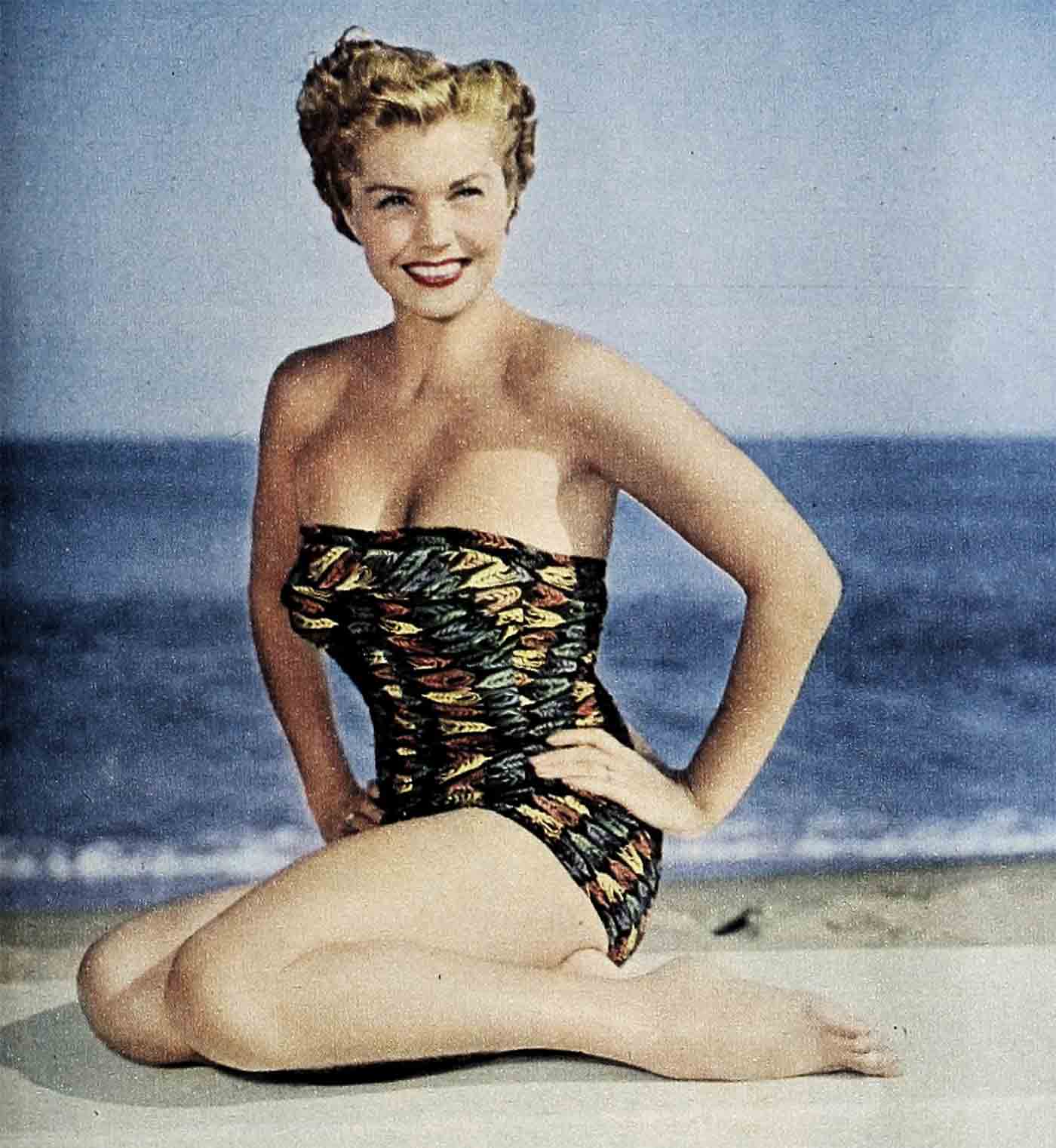
As for the calendar for which Marilyn posed, a few years back, before discovery, she gets calls for it. She wore her own pretty skin for that and nothing more. So great is the demand for the calendar, she herself can rarely get one, but one particular kid from Korea wrote her so often about it, that she finally did unearth one. Then she autographed it and mailed it to him at the front.
Marilyn is a bombshell, all right, a sizzling arrow straight through male hearts. But still she isn’t, as yet, an international incident. Esther Williams, as a pinup, is that. This episode in the Williams life began back in 1944:
She was flooded with pinup requests, naturally, and among the souvenirs she sent out to the boys was a photograph of herself in a white one-piece bathing suit. She was standing on tiptoe, as she usually does, and leaning back against the trunk of a palm tree.
One of those pictures wound up decorating the wardroom of a certain U. S. destroyer.
This destroyer must remain anonymous because there came to its wardroom some visiting British naval officers. They were, you may be sure, the very soul of honor. Toasts were drunk to our Navy, to their Navy, and to hands across the sea. But when the British officers returned to their destroyer, somehow or other, Miss Williams’ picture, frame and all, had returned with them.
Now no one is saying that the British stole it. No one is saying either that our men stole it back. But it did get back to our side, somehow or other, the very next day, without any explanations.
It became “operation mermaid” after that. Wherever the British and American destroyers happened to mingle, Esther changed sides quicker than a hot buck a gambling house.
So you can imagine Miss Williams’ pleasure when the other day, from Korea, this same picture came back to her. The frame was really beat up. The picture itself was dog-eared. But the request was direct and wonderful. “Please send us a new print of this photograph,” asked the officers of the wardroom of the original destroyer. “You see, there are some British anchored port side and we want to prove to them that you are as lovely as always—and always ours.”
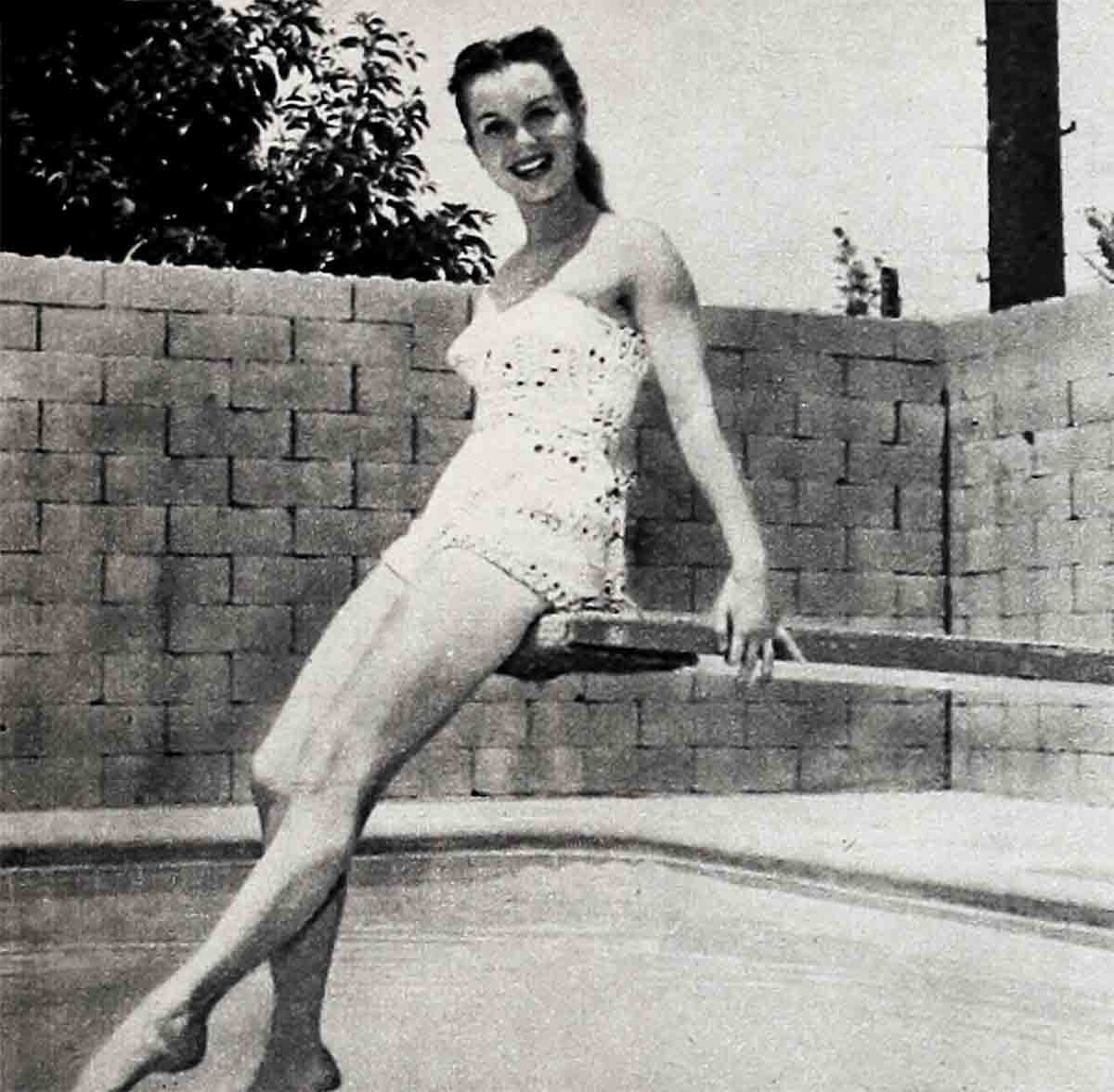
Not only did the boys get their picture, but it had a new frame. They received second picture, too, just like the first, only autographed to every member of the crew.
As for Debbie Reynolds, the pinup stories about her could go on and on, but the nicest yarn of all is about the tail gunner in a plane over Korea. He originally wrote Debbie asking for her photograph because she looked, he said, like the girl back home whom he had lost. They had been engaged and then she got polio, and died of it, before he was able to get leave and see her.
Now Debbie makes a very special thing about her servicemen mail. She puts her own private address on the answers to their letters. Any guy in uniform who turns up in Hollywood and wants to call on her is made to feel right at home. There is even a rule in the Reynolds neighborhood that if any uniformed male comes around, and the Reynolds are away, the neighbors are to entertain him till they get back.
Naturally, therefore, this lonely airman’s touching request went right to Debbie’s sympathetic little heart. She sent off the picture immediately. The boy wrote back, thanking her, saying he had it pasted in his plane, right over the gun that was his to fire, and that whenever he went into action, he always touched it for luck.
Weeks went by, and then she got a letter, containing the picture, riddled to bits. “A flock of MIG’s came by us real sudden,” the boy wrote. “I leaned back to touch your face—and saved my life. But you can see hew those bullets grazed the photograph, so may I have another?”
Debbie is also painted on the side of a tank, which its crew writes her has crossed the thirty-eighth Parallel in Korea “at least a million times.” The gang caIl the tank “Abadaba Honeymoon” in her honor.
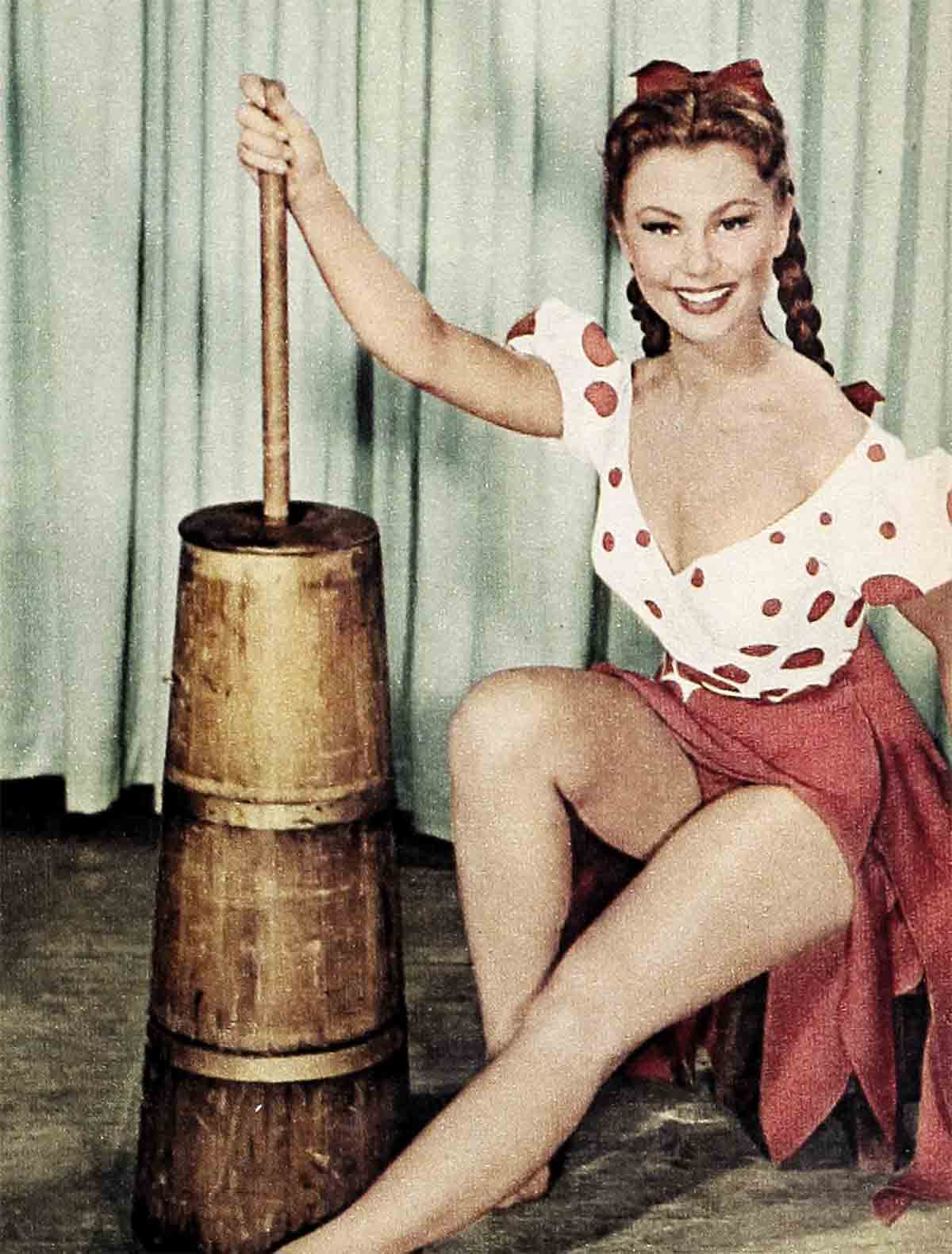
Mitzi Gaynor is a girl whom the boys think of with nicknames, too. Too many nicknames for her own comfort. “There’s a bunch of bombardiers who wrote me that they had voted me ‘The girl we’d most like to explode with,’ ” says bubbling Mitzi. “Then a demolition outfit wrote that I was ‘The girl we’d most like to rescue.’ Later, I received a letter from a company in our occupation army, stationed at Kimpo, Japan. They said, ‘You are the girl we’d most like to come home to.’ My only problem is, what with the first two titles, what shape they’d find me in.” The shape they find Mitzi in, in her pinup poses, is strictly from heaven, cool, crazy and double-bubble.
Janet Leigh has most visibly what it takes to be a perfect pinup but the pinup request which touched her most of any she has ever received was sent her by a girl—a Japanese girl from Tokyo.
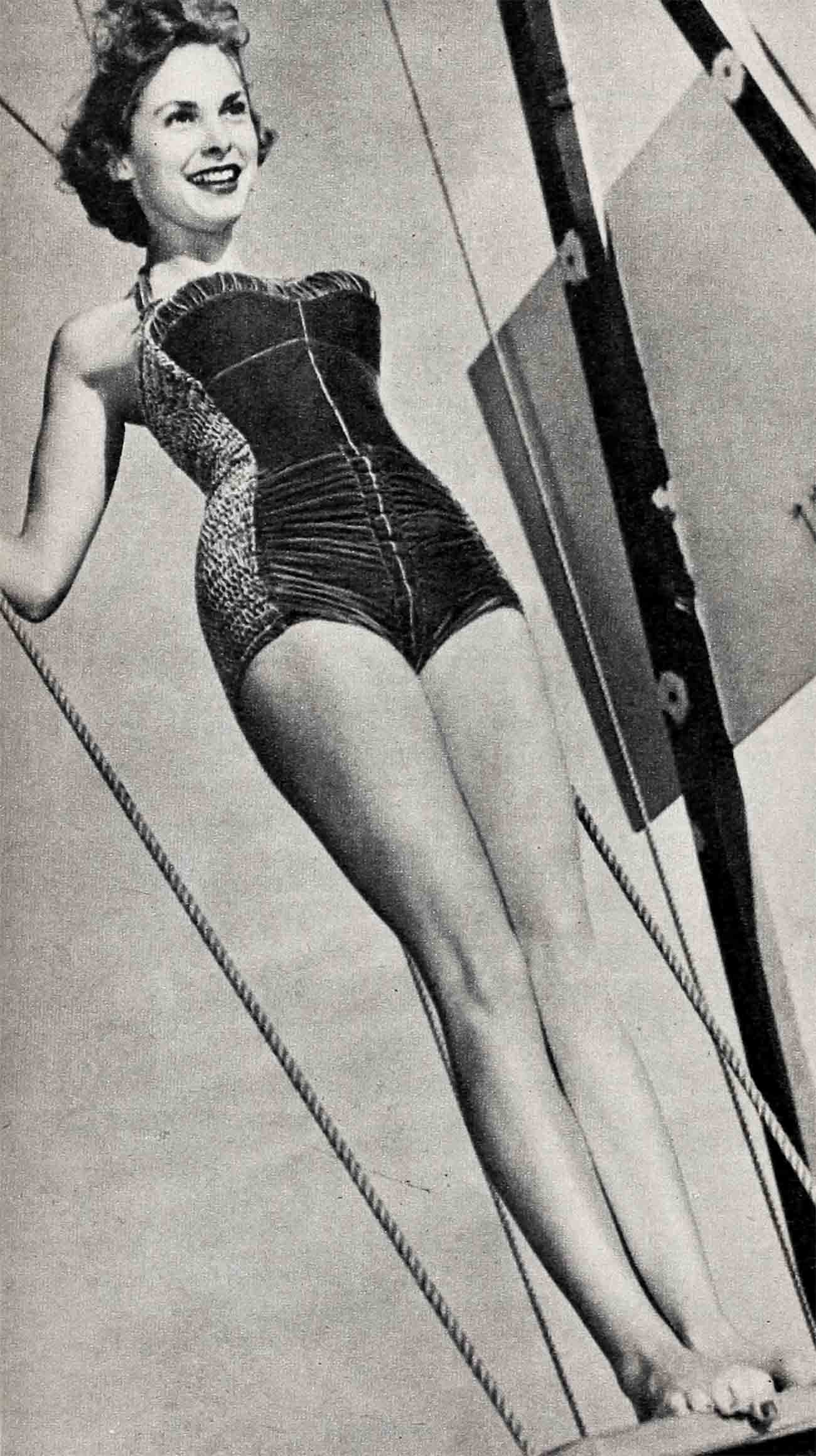
Actually, it was sent to Janet, via Marshall Field’s, the super-department store in Chicago. And, flatteringly enough to Photoplay, it contained a picture of Janet in a rose bathing suit, torn from the pages of this magazine. How the little Japanese girl knew about Marshall Field’s neither Janet nor that store will ever know, and whether or not this is a “Madame Butterly” situation in the making is a question, too.
But the little Nipponese wrote in pidgeon English, “Please send me suit like this only in blue, size thirteen two. Please send airmails for me have date American soldier week next.”
Janet actually did dispatch the suit but so far she’s had no reply.
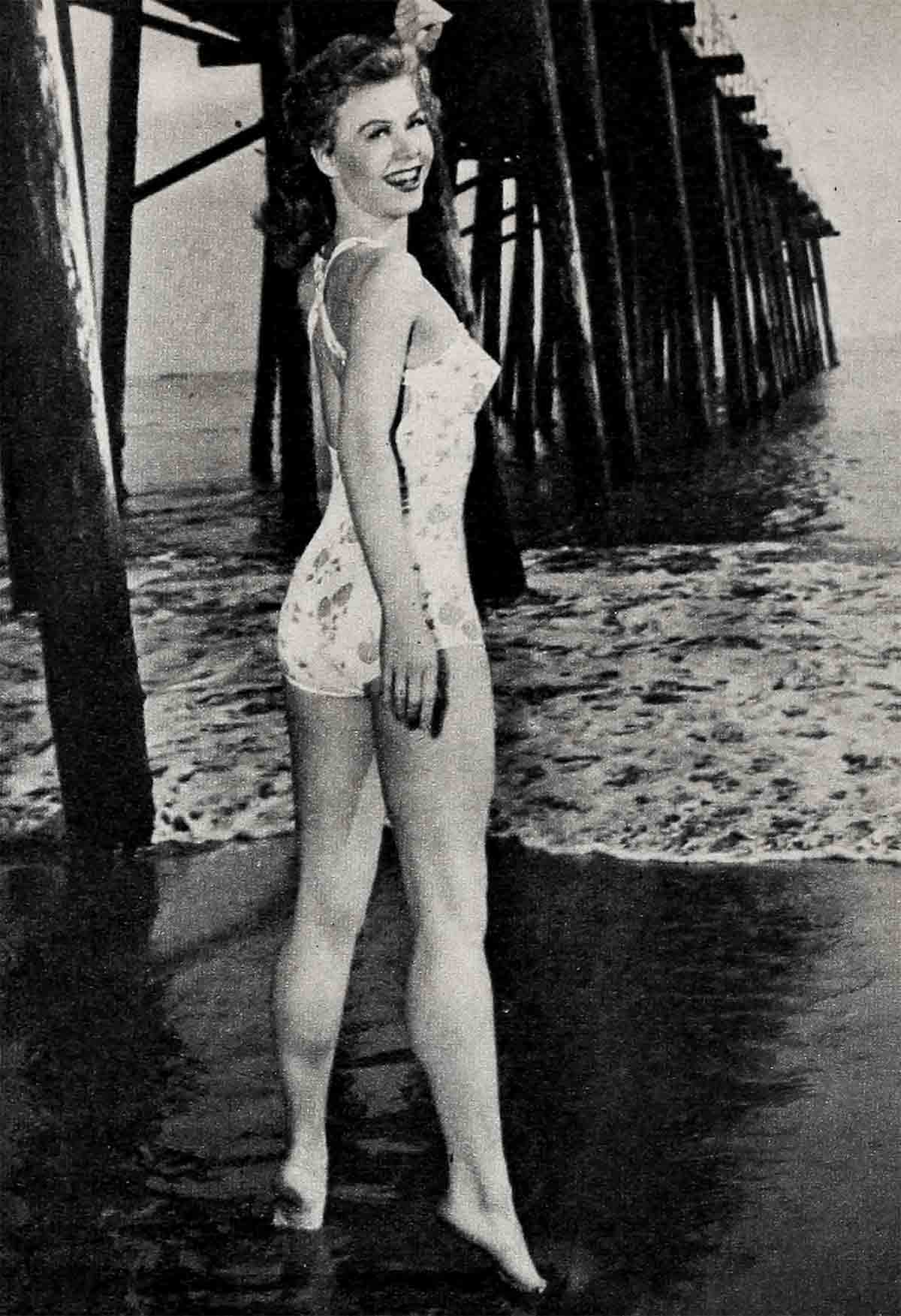
Vera-Ellen says the response to her pinup pictures will probably change her private life. “I started sending out nice little portraits of myself,” Vera says, “and I’d get back thank-you notes from the boys saying, ‘You’re so nice. You make me think of my sister.’ Then the studio ‘shot some real leggy ones of me and the letters came in saying, ‘Hi, girl. Are you married?’ ”
She was a very bewildered chick, however, when she suddenly got a request for one beautiful long-limbed pose of herself, but “in a size not bigger than one inch by two and could we have 300 copies of it.” It turned out the letter came from a whole battalion, heading into battle. They wanted the little pictures of Vera to paste inside their helmets for good luck. They got them, too.
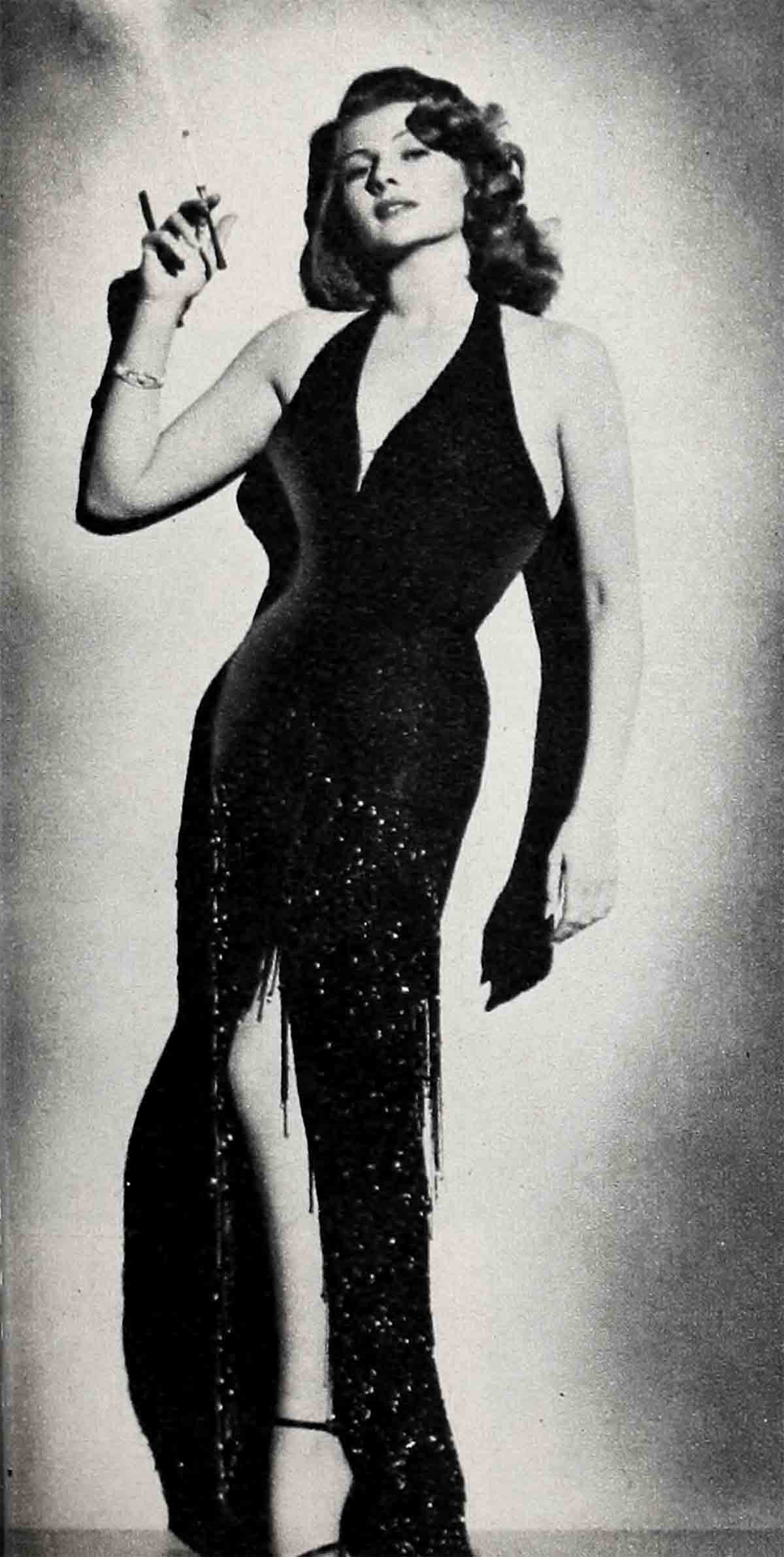
Rita Hayworth’s favorite pinup letter followed her for nearly five years before it caught up with her. It is in eight pages of finely hand-written German, postmarked “Berlin” and originally written just after hostilities ceased in that beleaguered capital.
Translated, Rita discovered that the writer had been a twenty-year-old German officer during the Battle of the Bulge. In a bunker on that bitter battlefield he came upon the most famous picture of Rita—the one in the sheer black negligee—and, in his words, “. . . in all that agony and death, it seemed unbelievable that anything as beautiful as you could be alive in the world.”
He cherished the picture, hid it in his kit, and when he was taken a prisoner of war by the Americans, he still had Rita with him. But in the prison camp, he somehow lost her. After peace was declared and he was free, back in the capital of his birth, he wrote Miss Hayworth asking for another photograph. You see, at that time, like many another European, he had no home, no work, nothing save a friend’s address for mail.
Unfortunately, however, by the time his letter arrived in Hollywood, Rita had sailed for Europe, to meet with a man named Aly Khan. The letter was forwarded to her in Paris, but by that time, she was trotting all around Europe with the Prince. So the letter followed, but always late. Then she married—and did more traveling. Then she wanted a divorce—and did still more traveling. Finally she came back to Hollywood by way of a side trip to Mexico. Rita began work at Columbia Studios on “Affair in Trinidad,” and the letter and she caught up with one another. And now at last her newest glamour pinup shot has gone to Berlin. But Rita has no idea whether the German ex-officer is starving or prosperous, or even alive.

Jean Peters has complained to her studio, Twentieth Century-Fox, that if she got cast in any more ragged roles, the public would never know what she really looked like. Her complaint got her into the photographic gallery for pinup art. And then the joke was that it turned out to be the first time the studio had ever fully comprehended what she looked like, a la bathing suit—and they whistled! Now Jean’s being cast in musicals like “Wait Till the Sun Shines, Nellie.”
Jean is a college girl and despite her stardom, in her private life she sticks much closer to collegiate groups than to members of the film colony. And, interestingly enough, since her pinup pictures have gone out to the camps, it is the college men in uniform who most often write her. They are usually officers, a little shy about writing an unknown movie star. “They are usually married, too,” Jean tells you, a little ruefully. “They write and tell about their wives, their children. One wrote me a long letter about the son and heir he knew he’d had, but whom he had never seen. He told me he couldn’t write to his wife that way, for fear his loneliness would make her more lonely, too. Now we are regular correspondents and when he’s back from the front I hope to meet him—and his wife and child.”
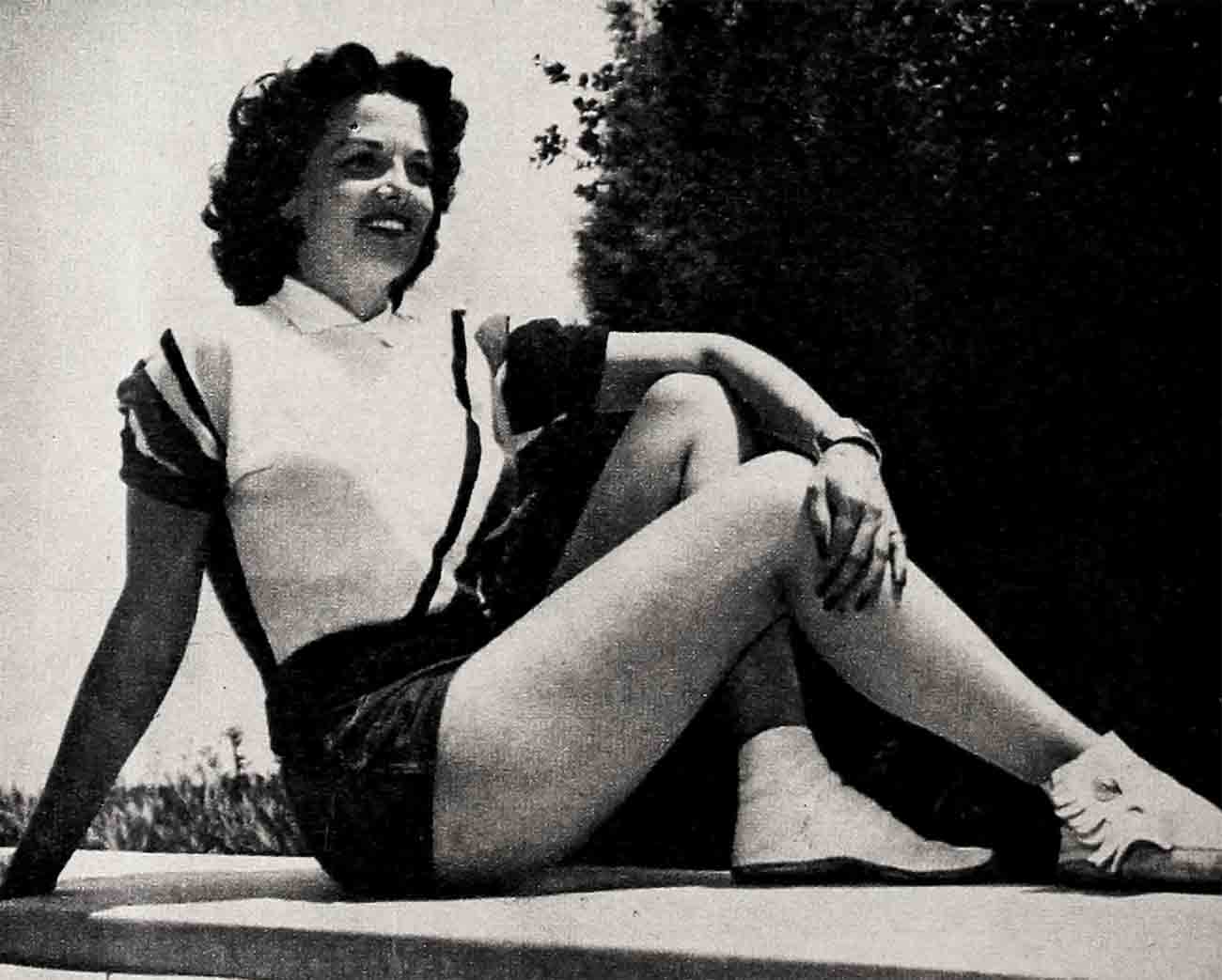
Of course, sometimes there is real peril in pinups. Take Jane Russell, for instance. She definitely dislikes all this publicity about her anatomy, does Jane. She is very, very much married to the boy she fell in love with in high school, Bob Waterfield. She is very religious—never misses a church service, and teaches a Sunday-school class and a Bible class. Yet, because of the exaggerated sexy publicity she got at the very beginning of her career, a certain percentage of young fellows still think of her as a kind of Junior Mae West and that they can, therefore, “come up and see her some time.”
Recently, while Jane was working on Paramount’s “Son of Paleface,” three soldiers got her address and turned up on her doorstep one evening. As her car drew up to her doorway, the three of them stood up. “We’re taking you out with us this evening,” they announced.
They hadn’t noticed that another car was drawing up right behind Jane’s. Out of this one stepped Bob Waterfield, who is a professional athlete. “Hi,” he said to the astonished soldiers. “That’s a great idea. We’ll all go out. Let’s go bowling.”
This was not what the boys had had in mind—but they were stuck with it.
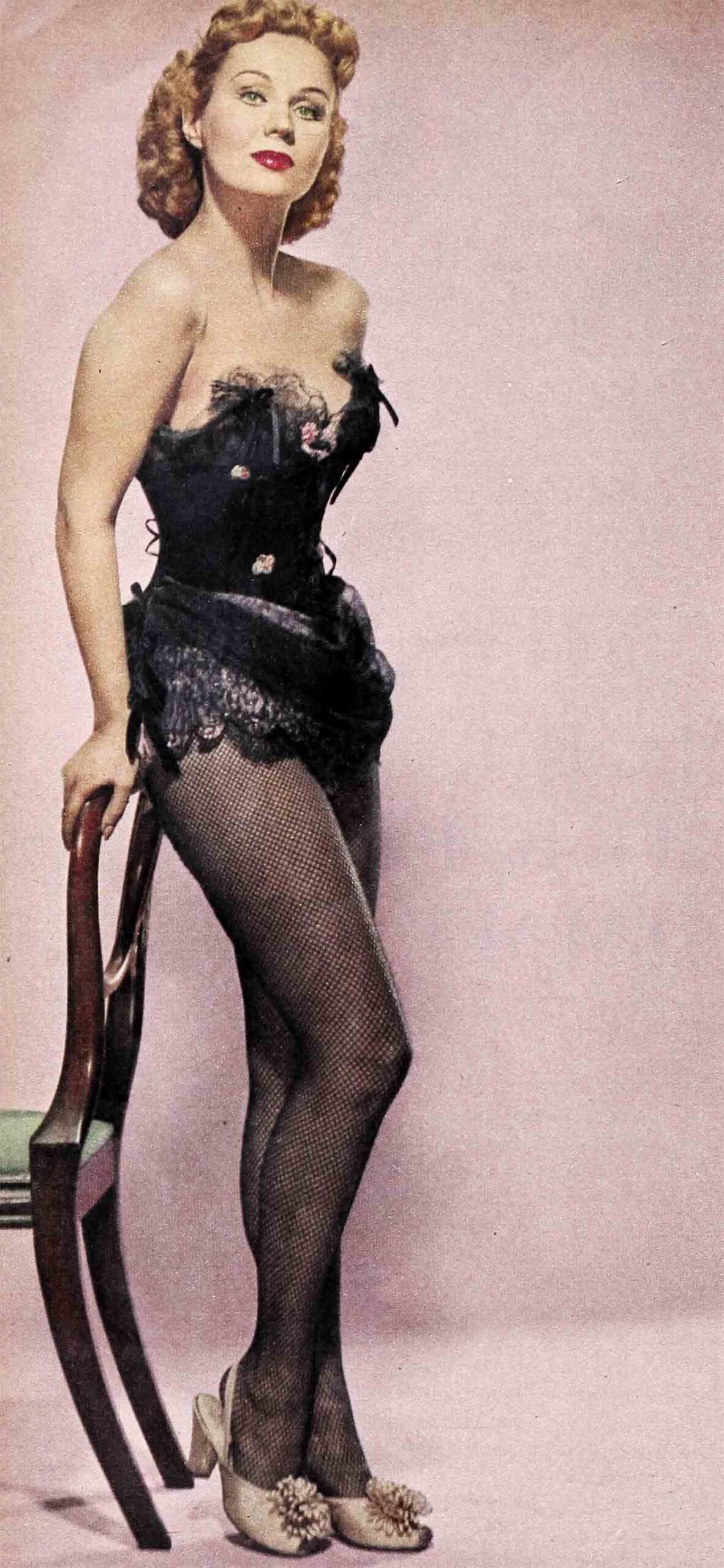
Virginia Mayo is somewhat like Jane, They make her a sexboat on screen, but off-screen she is very quietly and happily married to Mike O’Shea. Virginia too is active in church work. She is without exception the most obliging of stars when it comes to any request, with the result that she has stood still for literally thousands of pinup poses. She gets a vast volume of pinup fan mail from all service: centers. And while Virginia turns all! other fan mail over to a secretary, every letter from a guy in uniform gets her own personal reply.
That’s how Ginny got the letter from the chap who wanted to leave his wife! because of her. He wrote Virginia that he had fallen out of love with his bride, largely because she was so sloppy. She never really combed her hair, he said. She’d let her figure go. When she put on lipstick, it was always crooked.
Because the small city from which he came, and which he’d mentioned in his first letter, was one where Warner Brothers has an office, it wasn’t too much trouble for Virginia to discover his wife’s address. Their name was distinctive, and they had recently had twins.
Whereupon she wrote the soldier and told him what trouble her beauty care entailed—the hours, the dollars. Then she wrote the wife and very frankly and sweetly sent her her own diet, and special beauty tips. The wife wrote back almost at once, and you could practically see the tears in her eyes as she was writing—tears of gratitude. She told Virginia she had gone only that evening to see one of her pictures. She said she was right that moment on the diet.
The husband wrote back to Virginia that he hadn’t quite realized the care it took to be beautiful, or the money. The payoff came about six months later.
“What do you know,” said the letter, “my wife has been reducing, and she sent me her picture. She’s Had her hair cut like yours. She’s got a dress something like the one you wear in ‘She’s Working Her Way through College.’ Since you tell me you are so happily married, I hope you’ll understand how happy I feel now, falling in love with my bride again. But isn’t it wonderful, Virginia, that all on her own she got wise, finally?”
THE END
—BY RUTH WATERBURY
It is a quote. PHOTOPLAY MAGAZINE SEPTEMBER 1952




